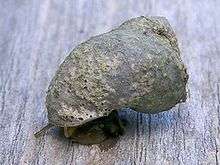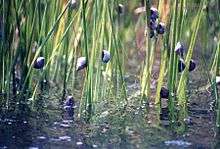Littoraria irrorata
Littoraria irrorata, common name the marsh periwinkle, is a species of sea snail, a marine gastropod mollusk in the family Littorinidae.[2] The specific epithet irrorata means 'moistened' or 'dewy.'
| Littoraria irrorata | |
|---|---|
 | |
| The shell of this Littoraria irrorata individual is covered in the lichen Pyrenocollema halodytes | |
| Scientific classification | |
| Kingdom: | Animalia |
| Phylum: | Mollusca |
| Class: | Gastropoda |
| Clade: | Caenogastropoda |
| Clade: | Hypsogastropoda |
| Order: | Littorinimorpha |
| Family: | Littorinidae |
| Genus: | Littoraria |
| Species: | L. irrorata |
| Binomial name | |
| Littoraria irrorata | |
| Synonyms[2] | |
This species occurs in salt marshes on the Atlantic coast and Gulf Coast of North America, from Massachusetts to Texas.
Some colonies of this species of snail are the only mollusks known to practice fungiculture.[4]
Distribution
This species can be found along Ireland, the Northwest Atlantic Ocean and the Gulf of Mexico.
Ecology

Feeding habits
Littoraria irrorata feeds on fungi that it encourages to grow. It creates and maintains wounds on the grass, Spartina alterniflora, which are then infected by fungi, probably of the Phaeosphaeria and Mycosphaerella genera. Such fungi are the preferred diet of the snail. L. irrorata also deposits faeces on the wounds that they create, which encourage the growth of the fungi because they are rich in nitrogen and fungal hyphae. Juvenile snails raised on uninfected leaves do not grow and are more likely to die, indicating the importance of the fungi in the diet of L. irrorata.[6]
Habitat
The minimum recorded depth for this species is 0 metres (0 ft); maximum recorded depth is 22 metres (72 ft).[5]
References
- "Littoraria irrorata". NCBI taxonomy. Bethesda, MD: National Center for Biotechnology Information. Retrieved 29 September 2017.
Lineage( full ) cellular organisms; Eukaryota; Opisthokonta; Metazoa; Eumetazoa; Bilateria; Protostomia; Lophotrochozoa; Mollusca; Gastropoda; Caenogastropoda; Hypsogastropoda; Littorinimorpha; Littorinoidea; Littorinidae; Littoraria
- Reid, David G. (2011). Littoraria irrorata (Say, 1822). Accessed through: World Register of Marine Species at http://www.marinespecies.org/aphia.php?p=taxdetails&id=419566 on 2011-05-16
- Say, Thomas (24 July 1821). "An Account of some of the Marine Shells of the United States" (pdf). Journal of the Academy of Natural Sciences of Philadelphia. II (2): 239–240. ISSN 0885-3479. LCCN 12030018. OCLC 1460713. Retrieved 18 January 2018.
- Brian R. Silliman , Steven Y. Newell (2003). "Fungal farming in a snail". Proceedings of the National Academy of Sciences. 100 (26): 15643–15648. Bibcode:2003PNAS..10015643S. doi:10.1073/pnas.2535227100. PMC 307621. PMID 14657360.
- Welch J. J. (2010). "The "Island Rule" and Deep-Sea Gastropods: Re-Examining the Evidence". PLOS One. 5 (1): e8776. Bibcode:2010PLoSO...5.8776W. doi:10.1371/journal.pone.0008776. PMC 2808249. PMID 20098740.
- Silliman, B.; Newell, S. (2003). "Fungal farming in a snail". Proceedings of the National Academy of Sciences of the United States of America. 100 (26): 15643–15648. Bibcode:2003PNAS..10015643S. doi:10.1073/pnas.2535227100. PMC 307621. PMID 14657360.
- Reid, D.G. (1986). The littorinid molluscs of mangrove forests in the Indo-Pacific region. British Museum (Natural History), London
- Reid, D.G. (1989a). "The comparative morphology, phylogeny and evolution of the gastropod family Littorinidae". Philosophical Transactions of the Royal Society of London, Series B. 324 (1220): 1–110. Bibcode:1989RSPTB.324....1R. doi:10.1098/rstb.1989.0040.
- Reid, D.G., Dyal, P. & Williams, S.T. (2009) Global diversification of mangrove fauna: a molecular phylogeny of Littoraria (Gastropoda: Littorinidae). Molecular Phylogenetics and Evolution
- Rosenberg, G., F. Moretzsohn, and E. F. García. 2009. Gastropoda (Mollusca) of the Gulf of Mexico, Pp. 579–699 in Felder, D.L. and D.K. Camp (eds.), Gulf of Mexico–Origins, Waters, and Biota. Biodiversity. Texas A&M Press, College Station, Texas
External links
- Malacolog info

